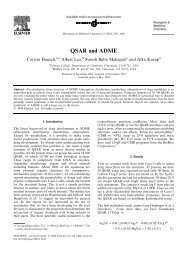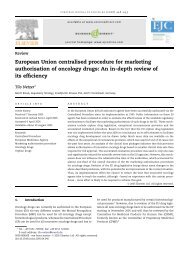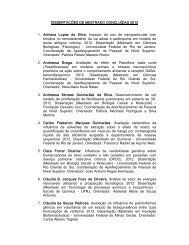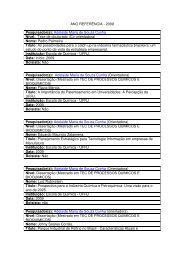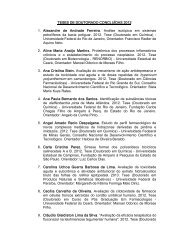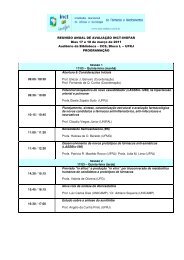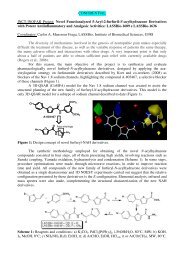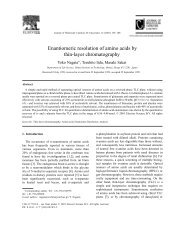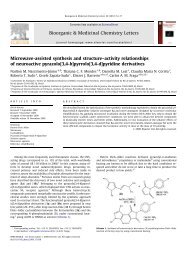Annual Activities Report 2011 - INCT-Inofar - UFRJ
Annual Activities Report 2011 - INCT-Inofar - UFRJ
Annual Activities Report 2011 - INCT-Inofar - UFRJ
You also want an ePaper? Increase the reach of your titles
YUMPU automatically turns print PDFs into web optimized ePapers that Google loves.
<strong>Annual</strong> <strong>Report</strong> <strong>2011</strong> | <strong>INCT</strong>-INOFAR<br />
43<br />
Highlights<br />
LASSBio-772 is a novel alpha 1 adrenoceptor antagonist that presents higher affinity for the alpha<br />
1A/1D than alpha 1B-AR, being therefore putatively useful for the treatment of the lower urinary tract<br />
symptoms, including the benign prostatic hyperplasia in mammals.<br />
References:<br />
[1] Ma, P.; Zemmel, R. Nature Rev. Drug Discov. 2002, 1, 571.<br />
[2] Lepor, H.; Tang, R.; Meretyk, S.; Shapiro, E. J. Urology 1993, 150, 252.<br />
[3] Kuo, G-H.; Prouty, C.; Murray, W. V.; Pulito, V.; Jolliffe, L.; Cheung, P.; Varga, S.; Evangelisto, M.;<br />
Wang, J. J. Med. Chem. 2000, 43, 2183.<br />
Quercetin Reduces Neutrophil<br />
Recruitment Induced by CXCL8,<br />
LTB4, and fMLP: Inhibition of Actin<br />
Polymerization<br />
Souto, F.O.; Zarpelon, A. C.; Staurengo-Ferrari, L.; Fattori, V.; Casagrande, R.; Fonseca, M. J. V.;<br />
Cunha, T. M.; Ferreira, S. H.; Cunha, F. Q.; Verri Jr, W. A. J. Nat. Prod. 74 (<strong>2011</strong>) 113-118.<br />
DOI:10.1021/ np1003017<br />
Quercetin is known as a prototype antioxidant flavonoid, and most of its widely recognized biological<br />
effects are related to antioxidant properties. Recent in vitro data have suggested that the quercetin does<br />
not affect the functioning of neutrophils. These work aimed to investigate whether quercetin inhibits<br />
neutrophil recruitment in vivo and in vitro and if such activity depends on diminishing the expression<br />
of receptors for chemotatic inflammatory mediators and/or actin polymerization. Male Swiss mice were<br />
treated with quercetin (30, 100 and 300 mg/kg, s.c.) and 1 hour after, the cell migration was stimulated<br />
by intraperitoneal injections of chemotatic factors such as CXCL1, CXCL5, LTB4, and fMLP. Quercetin<br />
inhibited the recruitment of neutrophils to the peritoneal cavity (Fig 1).




